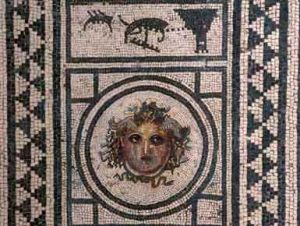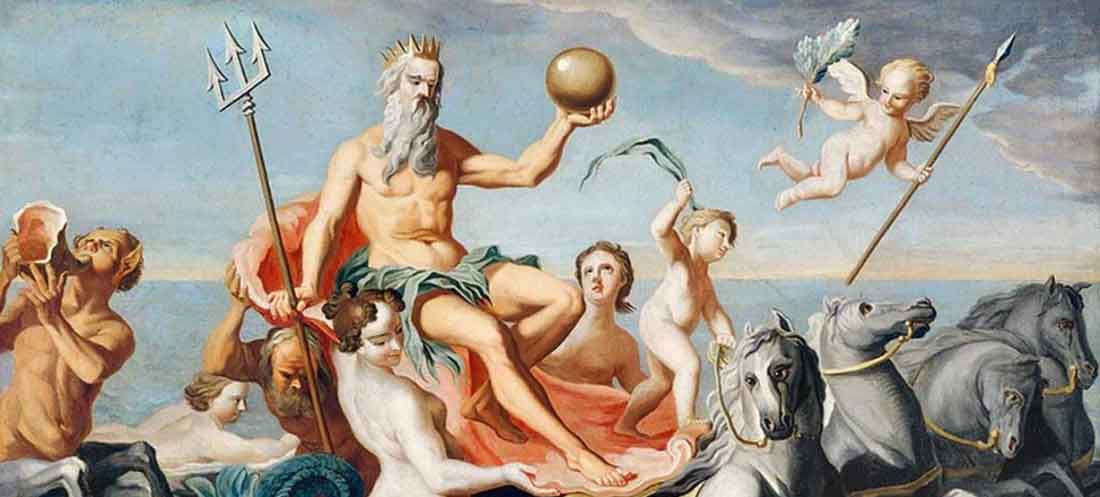The myth of Medusa in Greek Mythology

The three Gorgons of Greek mythology, according to Hesiod, “lived far away, at the end of the night across the Atlantic Ocean, where the Hesperides lived.” Unlike Stheno and Evryali who were immortal, Medusa was mortal. In addition, Medusa became better known than her two sisters through the story of her death.
In Theogony there is a reference to the moment of Medusa’s death at the hands of Perseus, however there is no extensive reference to her face. On the contrary, in Ovid’s work, “Metamorphoses”, a more complete description is given both of the beheading of the Gorgon by Perseus and of its appearance.
Diodorus preserves a welfar historical interpretation of the myth of the Mermaids and Medusa. So he delivers the following:
The Gorgons were a warlike people who lived in a country on the borders of the land of the Atlanteans. When the Amazons defeated the Atlanteans and captured the city of Cerni, they treated the vanquished with cruelty, killing the men, abducting women and children, razing the city – so that none of the rest dared to resist.
Indeed, the Atlanteans accepted the suzerainty of the Amazons, gave gifts and voted tributes to them, in order to win their indulgence and favor. In return they asked to be freed from the warlike neighboring people of the Gorgons.
Fierce battles took place between the Amazons and the Mermaids, until the former, with swords, spears, and bows for offensive weapons, and with defensive shields of the skins of great Libyan serpents, defeated the Mermaids and subdued them, killing many and capturing over three thousand.
Those who were rescued took refuge in a wooded area, and since the Amazon queen Myrina was unable to start a fire to completely exterminate the Gorgon tribe, she returned to the borders of her country. In later years, and as the Amazons had to face problems in their territory, the Gorgons grew stronger but were defeated by the diogenous Perseus while Medusa was their queen.
They were finally completely exterminated by the also diogenous Heracles, just like the Amazons, when the hero of Thebes arrived in the West and set up in Libya the columns that defined the boundaries of the world. Why did he find it grievous, at the moment when he decided to benefit the whole human race, to suffer female-dominated races

The monster had bronze arms and golden wings, with which he flew, sparkling eyes and a penetrating gaze.
With her gaze she petrified anyone who dared to look at her, even the gods avoided her, except Poseidon, who joined her and left her pregnant.
The birth of her children took place at the time of her death caused by Perseus, the son of Zeus and Danae.
It was also said that Medusa was beheaded for the sake of Athena, because she wanted to compete with the goddess in beauty. However, he lost his bond with Perseus. And anyway, whether beautiful or ugly, her mask was linked to the older gorgonian bond and functioned apotropaically, as in Athena, because it caught the eye of the invader and the assailant acting as a seducer and seducing him, making him miss his goal.
That’s why her mask was placed in sacred places as protection, on horses’ phalanxes, as a jewel, pin or earring or on the belt. Even dead in the underworld, Heracles feared her and attacked her, but Hermes told him that she was an idol without material substance.
The look of Medusa
When Perseus arrived in Ancient Aethiopia, where Kipheas reigned, he found his daughter Andromeda tied up, north of a sea whale, as a punishment of the Nereids to their mother Cassiepeia and Kipheas’s wife, who competed with them in beauty and boasted that she was of all.
The Nereids became angry, and Poseidon, who shared their anger, flooded the country as punishment and sent a whale.
Because Ammon reasoned that the country would be saved from disaster if the daughter of Cassiopeia Andromeda was given to the whale north, Kipheas was forced by the Ethiopians to do so and tied his daughter to a rock.
When Perseus saw her, he fell in love with her and promised Cepheus to kill the whale, on the condition that the king give his consent to this marriage, in case, of course, that Perseus saves her.
The two men exchanged vows that they would abide by the agreement, Perseus confronted the whale, killed it and released Andromeda. But Phineas, the brother of Kipheas, conspired against Perseus, because Kipheas had promised Andromeda his wife.
Perseus learned of the conspiracy and easily got rid of the conspirators by showing them the head of the Mermaid Medusa; at his sight everyone was petrified
Medusa’s ostrich
When Heracles began to gather an army and seek allies to campaign against the Lacedaemonians, he demanded that Cepheus of Arcadia and his twenty children join him in the war. But Cepheus feared that in his absence the Argives would attack his country and refused to participate.
Then Heracles took from Athena a sturgeon from Medusa’s hair in a bronze pitcher, gave it to Cepheus’ daughter Steropes, and told her, in case an enemy army approached menacingly, to take out the sturgeon and lift it three times over the walls, but without her looking at him, and the enemies would flee. After this, Cepheus set out on the campaign together with his children.
Medusa’s blood
And just as two children sprang from the head and blood of the decapitated Medusa, so her blood was both medicine and medicine: Asclepius practicing his art for a long time not only prevented some from dying but also raised the dead; for he took from to Athena the blood that flowed from the veins of the Mermaid, and the blood that had been shed from the left used to destroy people was poison while that which had flowed from the right veins for their salvation was beneficial, and with this raised the dead.
The Medusa girl
The fascination of a myth causes its variations. The myth of Medusa evolved until the Hellenistic years and of course any additions, subtractions, conversions went along with the dictates and ideology of the time and places.
Thus, Medusa from a primordial pre-Olympic monster turned into a beautiful but proud and haughty girl who dared to compare her beauty with Athena’s and find her superior. And Athena changed the girl’s hair into snakes.
It was also said that the reason for this transformation was her forced intercourse with the god Poseidon in a sanctuary dedicated to Athena. Of course, the wrath of the goddess could not be unleashed on a god, the necessary and forced victim was the mortal.
Medusa and Perseus

Flying with his winged sandals over the plains of Libya, the bloodstains that fell from Medusa’s head turned into poisonous snakes.
Medusa’s power reappeared as soon as Perseus met Titan Atlas. The young man asked him for a place to rest and he refused. So Perseus took out Medusa’s head and Atlas as soon as he saw it turned into a mountain!
On his difficult way to Serifos he met Andromeda, the daughter of the king of Ethiopia Kipheas and Cassiopeia. With Medusa’s head as a weapon, he defeated “Kitos”, a sea monster sent by Poseidon to avenge Cassiopeia, who was proud that her daughter was more beautiful than the Nereids. In the same way, Andromeda’s uncle fossilized the usurper of the throne of Argos.
In another myth it is said that during the absence of Perseus, Polydectes tried by force to make Danae his wife. Her rigid attitude angered him and he took her by force to the temple of Athena to sacrifice her. At that moment, Perseus arrives. Polydectes, not accepting the performance of the feat, challenges the hero to show him his head. The hero warns his family not to look and takes Medusa’s head out of the bag. Those who looked at it, including Polydectes, petrified at once. Thus the power of the head was confirmed, even dead, and Serifos was filled with stones that looked like people. After that Perseus dedicated his head to Athena, who took it and nailed it in front of her shield.
Among Medusa’s victims was Ariadne according to the testimony of Nonnos. The princess of Crete, loved by Theseus and later by Dionysus, was killed by Perseus or petrified by her terror—petrodea nymph, when she saw the head of Medusa held by Perseus. This happened in Perseus’ war with Dionysus and his Maenads.
Medousa by Ovid
Ovid initially describes Medusa as a beautiful girl with striking hair With her external appearance she attracted the attention of Poseidon, who lusted after her a lot and isolated her inside the sanctuary of Athena.
The goddess sought revenge on Medusa by turning her hair into snakes in order to literally petrify anyone who looked at her in fear.
“Medusa once had many lures to win someone’s love. A relatively large number of lovers fought. Those who had seen her in person had never seen such strong features in such a sweet face. However, what impressed them most was the length of her hair. “Golden curls waved and shone with grace”, Ovid writes in “Metamorphoses”.
